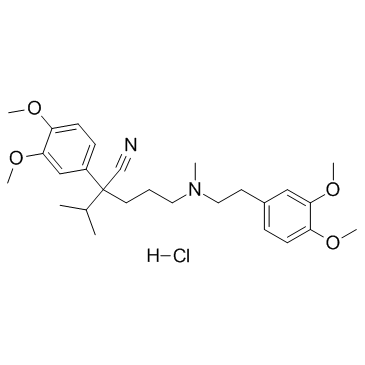152-11-4
| Name | (±)-Verapamil hydrochloride |
|---|---|
| Synonyms |
2-(3,4-Dimethoxyphenyl)-5-{[2-(3,4-dimethoxyphenyl)ethyl](methyl)amino}-2-(1-methylethyl)pentanonitrilhydrochlorid
2-(3,4-dimethoxyphenyl)-5-{[2-(3,4-dimethoxyphenyl)ethyl](methyl)amino}-2-(1-methylethyl)pentanenitrile hydrochloride MFCD00069355 Izoptin Hydrochloride Benzeneacetonitrile, α-[3-[[2-(3,4-dimethoxyphenyl)ethyl]methylamino]propyl]-3,4-dimethoxy-α-(1-methylethyl)-, hydrochloride (1:1) (±)-Verapamil hydrochloride 2-(3,4-dimethoxyphenyl)-5-{[2-(3,4-dimethoxyphenyl)ethyl](methyl)amino}-2-(propan-2-yl)pentanenitrile hydrochloride (1:1) Verogalid ER 2-(3,4-Dimethoxyphenyl)-5-{[2-(3,4-dimethoxyphenyl)ethyl](methyl)amino}-2-isopropylpentanenitrile hydrochloride a-[3-[[2-(3,4-Dimethoxyphenyl)ethyl]methylamino]propyl]-3,4-dimethoxy-a-(1-methylethyl)benzeneacetonitrile Monohydrochloride Verapamil Hydrochloride (Isoptin, Iproveratril, Calan) Verapamil hydrochloride,α-[3-[[2-(3,4-Dimethoxyphenyl)ethyl]methylamino]propyl]-3,4-dimethoxy-α-(1-methylethyl)benzeneacetonitrilehydrochloride 5-[(3,4-dimethoxyphenethyl)(methyl)amino]-2-(3,4-dimethoxyphenyl)-2-isopropylpentanenitrile hydrochloride 4-cyano-4-(3,4-dimethoxyphenyl)-N-[2-(3,4-dimethoxyphenyl)ethyl]-N,5-dimethylhexan-1-aminium chloride benzeneacetonitrile, a-[3-[[2-(3,4-dimethoxyphenyl)ethyl]methylamino]propyl]-3,4-dimethoxy-a-(1-methylethyl)-, hydrochloride (1:1) benzeneacetonitrile, α-[3-[[2-(3,4-dimethoxyphenyl)ethyl]methylamino]propyl]-3,4-dimethoxy-α-(1-methylethyl)-, monohydrochloride dl-Verapamil Hydrochloride 2-(3,4-diméthoxyphényl)-5-{[2-(3,4-diméthoxyphényl)éthyl](méthyl)amino}-2-(1-méthyléthyl)pentanenitrile chlorhydrate 2-(3,4-Dimethoxyphenyl)-5-{[2-(3,4-dimethoxyphenyl)ethyl](methyl)amino}-2-isopropylpentanenitrile hydrochloride (1:1) Veraptin Arpamyl Veracim Verapamil hydrochloride (‘±)-Verapamil hydrochloride Vasolan Verexamil Drosteakard EINECS 205-800-5 Lekoptin Retard UNII:V3888OEY5R Verapamil (hydrochloride) |
| Description | Verapamil hydrochloride is a calcium channel antagonist. |
|---|---|
| Related Catalog | |
| Target |
Calcium channel[1] |
| In Vitro | Verapamil (hydrochloride) is an L-type calcium channel antagonist. The combination of Bortezomib and Verapamil (70 µM) markedly declines the viability of the JK-6L, RPMI 8226, and ARH-77 cell lines after 16 hours of culture[1]. The enzyme hydrolase activity of recombinant human carboxylesterase (CES2) is substantially inhibited by Verapamil with Ki of 3.84±0.99μM[2]. |
| In Vivo | Verapamil, a calcium channel antagonist, is injected i.v. into a femoral vein prior to ischemia. Verapamil (1 mg/kg) significantly decreases the incidence of ventricular arrhythmias including premature ventricular contractions (PVC), ventricular tachycardia (VT) and ventricular fibrillation (VF) for 45-min coronary artery occlusion. Total arrhythmia scores are significantly increased when the heart is subjected to ischemia (P<0.01 vs. sham). Verapamil (1 mg/kg) significantly prevented the enhancement of total arrhythmia scores induced by ischemia (P<0.01 vs. ischemia). Results indicate that Verapamil exerts an anti-arrhythmic property[3]. |
| Cell Assay | Cells (1×105) are treated with 10 nM Bortezomib and/or 70 µM Verapamil for 16 hours and incubated for another 4 hours with Alamar-Blue. Activity of the mitochondrial dehydrogenase results in conversion of the coloring, which is followed by measurement of the absorption using a spectrophotometer[1]. |
| Animal Admin | Rats[3] Adult male Sprague-Dawley (SD) rats (250−350 g) are used. Verapamil (1 mg/kg) is injected i.v. into a femoral vein 10 min prior to ischemia. A sham group undergoes the same surgical procedures, except the suture underneath the LAD is left untied. In another series of experiment, arrhythmia is induced by Bay K8644, an L-type calcium channel agonist, at a dose of 0.1 mg/kg given i.v. into the FV. Verapamil (1 mg/kg) is administered 10 min prior to Bay K8644. All injections are performed within 30 sec. |
| References |
| Density | 1.058g/cm3 |
|---|---|
| Boiling Point | 586.1ºC at 760 mmHg |
| Melting Point | 142 °C (dec.)(lit.) |
| Molecular Formula | C27H39ClN2O4 |
| Molecular Weight | 491.063 |
| Flash Point | 308.3ºC |
| Exact Mass | 490.259827 |
| PSA | 63.95000 |
| LogP | 5.89508 |
| Storage condition | Refrigerator (+4°C) |
| Water Solubility | soluble |
CHEMICAL IDENTIFICATION
HEALTH HAZARD DATAACUTE TOXICITY DATA
MUTATION DATA
|
| Symbol |

GHS06 |
|---|---|
| Signal Word | Danger |
| Hazard Statements | H301 + H311 + H331 |
| Precautionary Statements | P261-P280-P301 + P310-P311 |
| Personal Protective Equipment | Eyeshields;Faceshields;Gloves;type P2 (EN 143) respirator cartridges |
| Hazard Codes | T: Toxic; |
| Risk Phrases | R23/24/25 |
| Safety Phrases | S45-S36/37/39-S36/37 |
| RIDADR | UN 2811 6.1/PG 3 |
| WGK Germany | 3 |
| RTECS | YV8320000 |
| Packaging Group | III |
| Hazard Class | 6.1(b) |
| HS Code | 2926909090 |
| HS Code | 2926909090 |
|---|---|
| Summary | HS:2926909090 other nitrile-function compounds VAT:17.0% Tax rebate rate:9.0% Supervision conditions:none MFN tariff:6.5% General tariff:30.0% |


